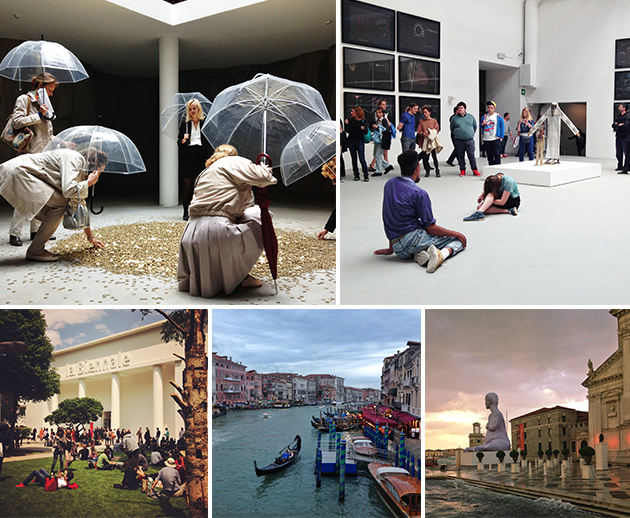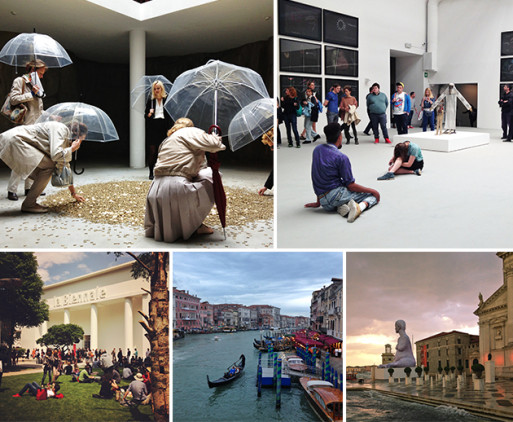
As the Venice Biennale takes over the city, Venice becomes a beautiful visual contradiction of Renaissance history and contemporary art, with a slight bit of fun. This year’s 55th biannual contemporary art festival, named “The Encyclopedic Palace” (after an 11-foot-tall model of a cylindrical skyscraper designed by Italian-born artist Marino Auriti in 1955), brings together 158 artists and 88 countries incorporating household names, international favorites and newcomers on the scene. The exhibition runs through November 24.
Though slightly more reserved in years past, the Biennale’s overall vibe is fun. Bells ring and colossal sculptures tower as viewers meander through the exhibition and its various events. In spite of a seemingly endless labyrinth of contemporary art, navigating through the Biennale isn’t difficult. First head to the Biennale Gardens (Giardini), where countries such as France, Germany, the U.S., Greece, Japan and Russia have historic pavilions with single or multiple artist exhibitions. Set up like a fair, it’s easy to traipse through the gardens and skip from pavilion to pavilion.
It is worth noting that every pavilion in the Giardini should be visited, if not for the art then for the diversity of presentation. Our favorites this year include the never-ending Centrale Pavilion, which houses more than 60 artists in 27 galleries showcasing painting, video, sculpture and craft. In Gallery 2, look out for Tino Sehgal’s live art pieces; one that involved humming and beat-boxing won him the coveted Golden Lion award for best artist this year.
Humor and sound reign supreme this year in the Giardini. The Russian Pavilion puts on an interesting display with Vadim Zakharov’s Danae and its women-only area section, where faux gold coins rain down in an open atrium on its female audience holding clear umbrellas. The Korea Pavilion’s Bottari is a sound and space installation by Kimsooja. A more aggressive sound installation is at the Polish Pavilion, where Konrad Smoleński’s large bronze bells ring on the hour. Even if you don’t enter, it’s worth it to stand in front of the France and Germany Pavilions, as the two swapped locations in a show of country camaraderie. France’s reboot on the German Pavilion is a multimedia installation of musical recordings by French-Albanian artist Anri Sala, while the German version of the French Pavilion features work by four international artists, including Chinese activist Ai Weiwei.
Once you’ve sufficiently explored the Giardini offerings, continue your Biennale experience by walking northwest through the exhibition to a former shipyard. The L-shaped Arsenale houses newer pavilions, such as Santa Sede (Vatican), United Arab Emirates, China and the Bahamas, the corderie — a long hallway of 16 rooms filled with exhibits and installations — and additional installations and performances. Tranfiguration, in the People’s Republic of China Pavilion, is a series of techno-fun videos, 3D installations and performances exploring transformation. The first-timer Bahamas Pavilion features Tavares Strachan’s Polar Eclipse, which is all about exploration in video and sculpture. In the Arsenale’s docks, SS Hangover is an ongoing kinetic sound performance by Icelandic artist Ragnar Kjartansson.
Over the past few decades, the Biennale has outgrown its original venue and consequently overflowed into other parts of Venice. In fact, some of the Biennale’s newer pavilions (Iran, Mexico, New Zealand) can be found throughout the city in churches or palazzos. So if you’re not intentionally planning a day of contemporary art, it may just bump into you on its own (Fondazione Querini Stampalia, Church of Sant’Antonin, Zuecca Project Space). Throughout the city, there are events (non-Biennale yet Biennale-approved) and museum and gallery exhibitions that are easy to stumble across, whether walking along a narrow Venetian calle (street) or riding on a vaporetto (water bus).
Photos Courtesy of Erica Firpo

